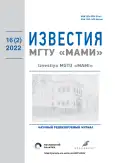The low power diesel-generator unit with electronically controlled fuel injection
- Authors: Galiullin R.R.1, Potapov V.I.1
-
Affiliations:
- Bashkir State Agrarian University
- Issue: Vol 16, No 2 (2022)
- Pages: 173-181
- Section: Electrotechnical facilities and systems
- URL: https://journals.rcsi.science/2074-0530/article/view/126623
- DOI: https://doi.org/10.17816/2074-0530-106005
- ID: 126623
Cite item
Full Text
Abstract
BACKGROUND: Diesel engines, used in generator units, primarily operate in variable loading conditions. Therefore, their technical and economic performance generally deteriorate when the load decreases. It arises from the diesel engine fuel system feature, where pressure and quantity of the fuel, injected into a cylinder, reduces with the load decreasing. As a result, the injection becomes “sluggish”, the quality of mixing process and combustion becomes worse.
AIMS: Improvement of effective indicators of the diesel-generator units with electronically controlled fuel injection.
METHODS: Adjustment of operation modes of the diesel engine of the electrical power unit carried out with use of electronically controlled Denso solenoid, connected to the high-pressure fuel pump via an adapter.
RESULTS: Results of the motor testing of the low power diesel-generator unit with electronically controlled fuel feed system are described in the article. The oscillograph charts of valve displacement and solenoid magnet winding current, presented in the article, confirm its operation efficiency. Sharp decrease in boost current at the stage of valve lift can be explained by onset of back EMF. Stable solenoid operation at diesel operation velocity of 3000–3100 min-1 is achieved by means of boost impulse supply to its winding. The boost impulse is supplied from a voltage upconverter and generated by discharge of preliminary charged booster capacitor.
CONCLUSIONS: Separated fuel feed adjustment in each high-pressure pump section made possible to reduce intersectional fuel feed irregularity to zero. Significant fuel consumption reduction was revealed with the motor testing of the low power diesel-generator unit with electronically controlled fuel feed system (the reduction reaches 10% on low loading operation modes). As mentioned by authors, transition to electronic control of operation modes of diesel engines of autonomous electrical power units does not require major engine design change – only to dismantle a mechanical controller and to set an adapter with electronically controlled bypass valve at a section of the high-pressure fuel pump. Electronic control unit supplies current to the valve. For autonomous electrical power units, transition to this control method can be done in typical repair workshop conditions, and an update of one unit (e.g. the KIPOR KDE19AE3) costs 13 950 rubles. By doing so, one electrical power unit may save up to 1191 liters of fuel and more than 63.96 thousands rubles at a cost of 53.7 rubles per liter.
Full Text
##article.viewOnOriginalSite##About the authors
Rustam R. Galiullin
Bashkir State Agrarian University
Email: rustam6274@mail.ru
ORCID iD: 0000-0003-1031-5068
SPIN-code: 5661-1922
Dr. Sci. (Tech.), Head of Department
Russian Federation, UfaViktor I. Potapov
Bashkir State Agrarian University
Author for correspondence.
Email: swooth@mail.ru
ORCID iD: 0000-0002-3438-0887
SPIN-code: 2631-4187
Senior Lecturer
Russian Federation, UfaReferences
- Gerasimov A, Tolmachev V, Utkin K. Dizel’-generatornye elektrostantsii. Rabota pri peremennoi chastote vrashcheniya dizelya. Novosti elektrotekhniki. 2005;(4). Available from: http://www.news.elteh.ru/arh/2005/34/13.php (In Russ).
- Galiullin RR, Miftakhutdinov FF. Kombinirovannoe elektronnoe regulirovanie toplivopodachi v avtonomnykh dizel‘-generatorakh maloi moshchnosti. Vestnik Bashkirskogo gosudarstvennogo agrarnogo universiteta. 2013;(3):92–96. (In Russ).
- Patent RUS № 2468230/ 13.04.2011. Byul. № 33. Galiullin RR, Safin AV, Potapov VI. Sposob regulirovaniya chastoty vrashcheniya dizel’-elektricheskogo silovogo agregata. Available from: https://www.elibrary.ru/item.asp?id=37502880 (In Russ).
- Patrakhal’tsev NN, Emmil’ MV. Formirovanie regulyatornykh kharakteristik dizelya otklyucheniem ra-bochikh tsiklov. Izvestiya MGTU «MAMI». 2013;1(2):271–274. (In Russ).
Supplementary files
















